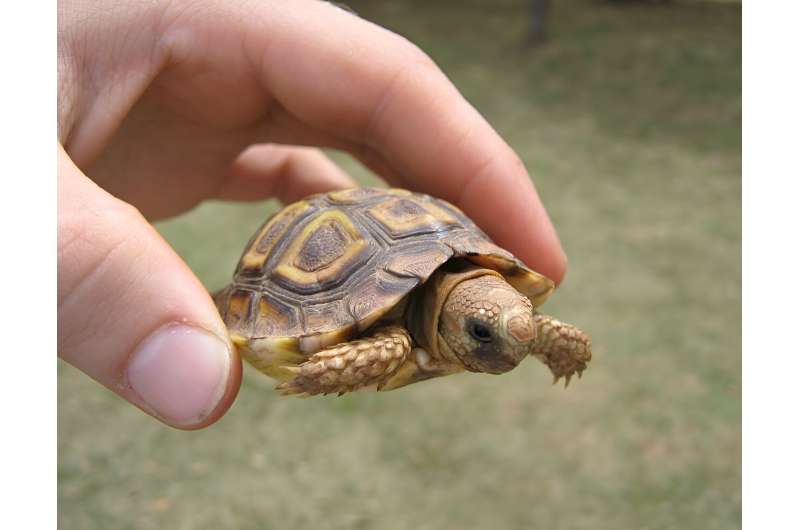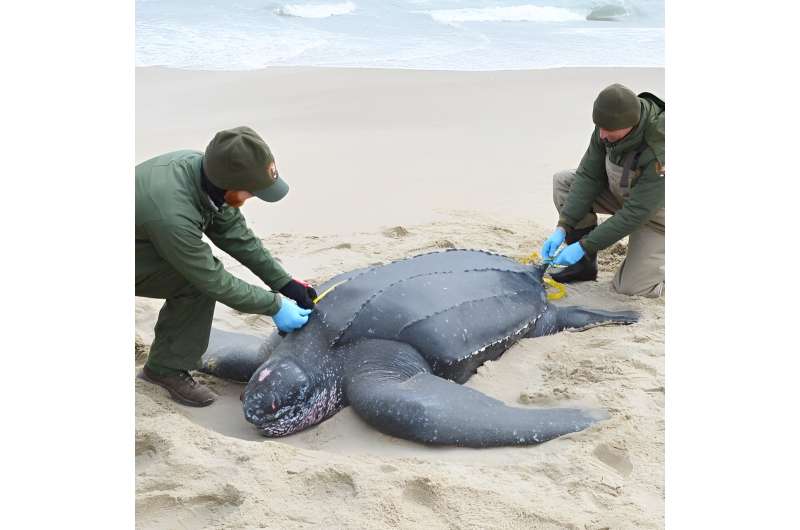This article has been reviewed according to Science X's editorial process and policies. Editors have highlighted the following attributes while ensuring the content's credibility:
fact-checked
peer-reviewed publication
trusted source
proofread
How turtles developed over the past 200 million years: Diversity of body size in turtles studied

International researchers, including Dr. Gabriel Ferreira of the Senckenberg Center for Human Evolution and Palaeoenvironment at the University of Tübingen, have compiled the most comprehensive data set to date on body sizes of recent and fossil turtles.
In their study, published in the journal Ecology and Evolution, the team concludes that—contrary to the common assumption—the size of the shell-bearers is not related to climatic conditions. Rather, the size evolution is determined by the animals' habits.
With a carapace length of about 100 millimeters, the terrestrial common padloper (Homopus areolatus) is one of the smallest turtle species alive today. The record at the other end of the scale is held by the leatherback sea turtle (Dermochelys coriacea) with a length of up to two meters, which is found in tropical and subtropicaloceans.
"Among fossil turtles, the range of body sizes is even more pronounced," says Dr. Gabriel Ferreira of the Senckenberg Center for Human Evolution and Palaeoenvironment at the University of Tübingen, and he continues, "We were curious about how this diversity of carapace sizes evolved over the last 200 million years, and what factors played the decisive role in this."
To this end, the research team, led by first author Bruna Farina of the Swiss University of Fribourg, compiled the most comprehensive data set on turtle body sizes to date.
The researchers recorded information on carapace lengths, preferred habitats, and the species' temporal occurrence in geological history for a total of 795 turtle species. "Previous studies that focused on the evolution of size often disregarded fossil species. Our results also incorporate data from 536 extinct turtle species—which is essential if you want to understand the evolutionary history and physical adaptations of the shell-bearers," adds Ferreira.

The new study shows that today's global climate does not appear to have a significant impact on the body size of the recent turtles that were studied. Nor did the correlation with paleotemperatures indicate any significant effect on the size of the fossil animals, the study finds. According to the study, the turtles' body size is determined by the animals' ecology and habitat preferences, rather than by climatic factors.
"The assumption that living organisms tend to increase in body size over the course of evolution, known as 'Cope's Law,' cannot be demonstrated in turtles," explains Ferreira, and hecontinues, "The size spectrum of freshwater species has remained fairly constant over the last 200 million years. In contrast, land and sea turtles show much more pronounced variation."
According to the team, the variation in body size among tortoises can be explained by their ecological diversity and varied habitats. This would allow the larger terrestrial species to disperse more easily. In sea turtles, on the other hand, the upper and lower limits of body size seem to be related to physiological constraints, such as thermoregulation or increased lung capacity, and morphological constraints, such as carapace size, as well as adaptations to life in open water. It is also possible that the need to go ashore for egg laying limits the maximum size of sea turtles, the researchers note.
"Our findings are very interesting, considering that body size in other animal groups—such as dinosaurs or crocodiles—is influenced by climatic factors, such as the temperature prevailing in the habitat. It underscores the turtles' unique nature," concludes Ferreira.
More information: Bruna M. Farina et al, Turtle body size evolution is determined by lineage‐specific specializations rather than global trends, Ecology and Evolution (2023). DOI: 10.1002/ece3.10201
Journal information: Ecology and Evolution




















